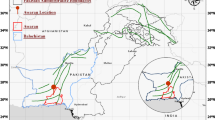Abstract
By using an alternative processing method for satellite infrared remote sensing data and adopting the China Geostationary Meteorological Satellite (FY-2C) infrared remote sensing brightness temperature data, we studied the great 2008 Wenchuan Ms8.0 earthquake. Results indicate the obvious characteristic period and amplitude, and distribution of thermal infrared anomalies before the Wenchuan earthquake. And we discussed the mechanism of the observed pre-earthquake thermal anomalies. The characteristics of observed thermal infrared anomalies are easy to be recognized and applied, and could provide a criterion for thermal anomalies of earthquakes.
Similar content being viewed by others
References
Richard A K. Tectonics: Pumping up the Tibetan Plateau from the far Pacific Ocean. Science, 2008, 321: 1028–1029
Richard S. Wenchuan earthquake: Damaged university mourns its dead and plans fast recovery. Science, 2008, 320: 1145
Richard S. Wenchuan earthquake: Lessons of disasters past could guide Sichuan’s revival. Science, 2008, 321: 476
Richard S. Wenchuan earthquake: Scientists race against the clock to gauge landslide risk. Science, 2008, 320: 1408
Tom P, Chen J, Eric K. Stress changes from the 2008 Wenchuan earthquake and increased hazard in the Sichuan basin. Nature, 2008, 454: 509–510
Zhang Z J, Wang Y H, Chen Y, et al. Crustal structure profile across Longmenshan fault belt from passive source seismic profiling. Geophys Res Lett, 2009, doi: 10.1029/2009GL039580
Deng Z H, Yang Z E, Sun Z M, et al. Complicated phenomena of the Beichuan-Yingxiu surface fracture zone during Wenchuan Ms8.0 earthquake in Sichuan Province, China. Chinese Sci Bull, 2008, 53: 3891–3896
Geller R J, Jackson D D, Kagan Y Y, et al. Earthquakes cannot be predicted. Science, 1997, 275: 1616
Gorny V I, Salman A G, Tronin A A, et al. The earth outgoing IR radiation as an indicator of seismic activity. Proc Acad Sci USSR, 1988, 30: 67–69
Qiang Z J, Dian C G, Wang X J, et al. Satelite thermal infrared anomalous temperature increase and impending earthquake precursor. Chinese Sci Bull, 1992, 27: 1642–1646
Qiang Z J, Xu X D, Dian C G. Impending-earthquake satellite thermal infrared and ground temperature increase anomalies. Chinese Sci Bull, 1991, 36: 1894–1900
Qiang Z J, Xu X D, Dian C G. Thermal infrared anomaly—precursor of impending earthquakes. Chinese Sci Bull, 1991, 36: 319–323
Tronin A A. Satellite thermal survey—A new tool for the study of seismoactive regions. Int J Remote Sens, 1996, 17: 1439–1455
Qiang Z J, Dian C G. Satellite infrared brightness temperature anomaly-earthquake imminent precursor (in Chinese). Sci China Ser D, 1998, 28: 564–573
Qiang Z J, Dian C G, Li L Z, et al. Satellitic thermal infrared brightness temperature anomaly image—short-term and impending earthquake precursors. Sci China Ser D, 1999, 42: 313–324
Tronin A A. Satellite thermal survey application for earthquake prediction. In: Hayakawa M, ed. Atmospheric and Ionospheric Electromagnetic Phenomena Associated with Earthquakes. Tokyo: Terrapub, 1999. 717–746
Tronin A A. Thermal IR satellite sensor data application for earthquake research in China. Int J Remote Sens, 2000, 21: 3169–3177
Zhang Y S, Shen W R, Xu H. Satellite thermal infrared anomaly before the Xinjiang-Qinghai border Ms8.1 earthquake (in Chinese with English abstract). Northwestern Seismol J, 2002, 24: 1–4
Tronin A A, Hayakawa M, Molchanov O A. Thermal IR satellite data application for earthquake research in Japan and China. J Geodyn, 2002, 33: 519–534
Zhang Y S, Guo X, Zhang X M, et al. Study on the inversion method of land surface temperature by applying IR bright temperature data of still satellite (in Chinese with English abstract). Northwestern Seismol J, 2004, 26: 113–117
Saraf A K, Choudhury S. Satellite detects surface thermal anomalies associated with the algerian earthquakes of May, 2003. Int J Remote Sens, 2005, 26: 2705–27
Saraf A K, Choudhury S. NOAA-AVHRR detects thermal anomaly associated with the 26 January 2001 Bhuj earthquake, Gujarat, India. Int J Remote Sens, 2005, 26: 1065–1073
Ma J, Chen S Y, Liu P X, et al. Temporal-spatial variations of associated faulting inferred from satellite infrared information: A case study of N-S seismotectonic zone in China (in Chinese). Chin J Geophys, 2006, 49: 816–823
Li Z H, Long P W, Ma H S. Seismogenic structure and earthquake sequences analysis on Wuqia earthquake with Ms6.8 on Oct. 5 in 2008 (in Chinese with English abstract). Inland Earthquake, 2008, 22: 355–360
Lu Z Q, Wu B H, Qiang Z J, et al. Brightness temperature anomalies in satellite-based thermal infrared remote sensing along the offshore china seas (in Chinese). Geoscience, 2005, 19: 74–82
Qiang Z J, Kong L C, Guo M H, et al. An experimental study on temperature increasing mechanism of satellitic thermo-infrared. Acta Seismol Sin, 1997, 10: 247–252
Wang Q L, Wang W P, Liang W F, et al. Stress-dissipative heat geotemperature precursor mechanism of earthquakes. Acta Seismol Sin, 1998, 11: 615–621
Qiang Z J, Xu X D, Dian C G. Thermal infrared anomalies under the non-temperature-increment background and the mechanism discussion. Chinese Sci Bull, 1991, 36: 1901–1906
Xu X D, Xu X M, Ma S D, et al. Preliminary inquiry into the causes of anomaly increase of air temperature by an impending earthquake. Acta Seismol Sin, 1995, 8: 149–154
Wakita H, Fujii N, Matsuo S, et al. “Helium spots”: Caused by a diapiric magma from the upper mantle. Science, 1978, 200: 430–432
Author information
Authors and Affiliations
Corresponding author
About this article
Cite this article
Zhang, Y., Guo, X., Zhong, M. et al. Wenchuan earthquake: Brightness temperature changes from satellite infrared information. Chin. Sci. Bull. 55, 1917–1924 (2010). https://doi.org/10.1007/s11434-010-3016-8
Received:
Accepted:
Published:
Issue Date:
DOI: https://doi.org/10.1007/s11434-010-3016-8




